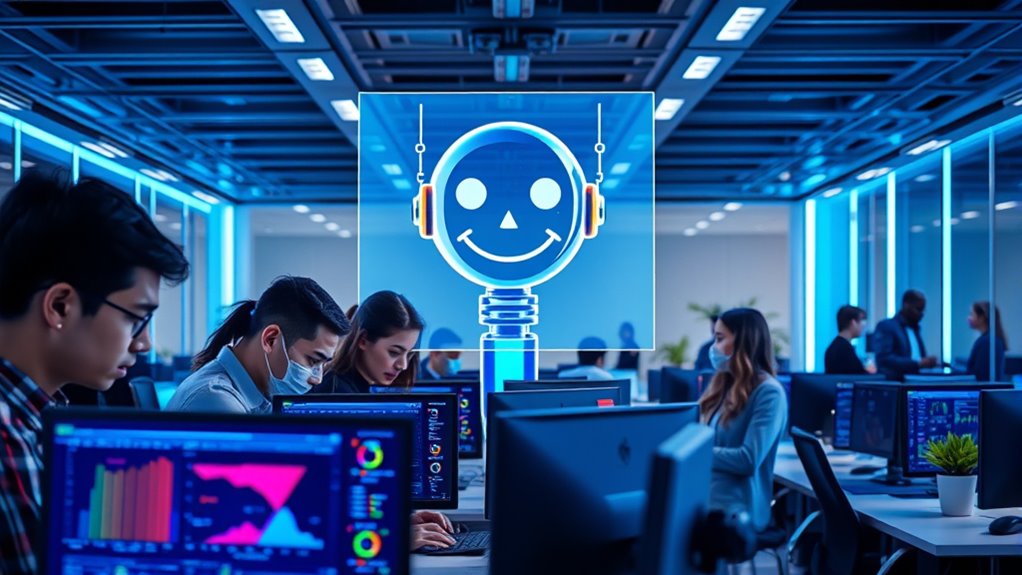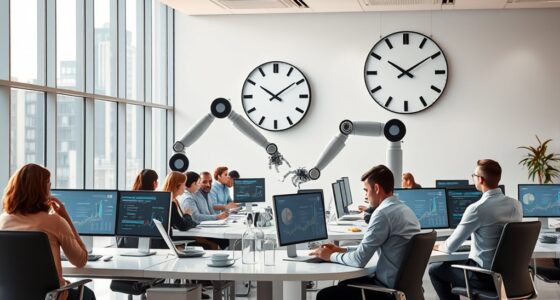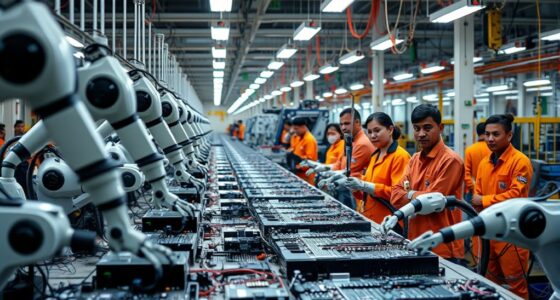Algorithms now actively manage many aspects of your work, monitoring performance, making decisions, and even guiding routines. While this boosts efficiency and reduces errors, it can also create feelings of surveillance, stress, and lack of control. Transparency and fairness often suffer, raising ethical concerns. As workplaces evolve, understanding how these systems impact you is essential. If you want to discover more about balancing human needs with algorithmic oversight, keep exploring this topic.
Key Takeaways
- Algorithms monitor and evaluate employee performance automatically, reducing human oversight and increasing efficiency.
- Transparency issues arise as decision-making processes of workplace bots are often hidden and difficult to interpret.
- Algorithmic management can impact worker well-being, causing stress, dissatisfaction, and feelings of powerlessness.
- These systems support operational improvements like faster task completion and data-driven decision-making.
- Clear policies and explainable AI are essential to ensure trust, fairness, and ethical use of workplace algorithms.
The Rise of Algorithmic Management in Modern Workplaces
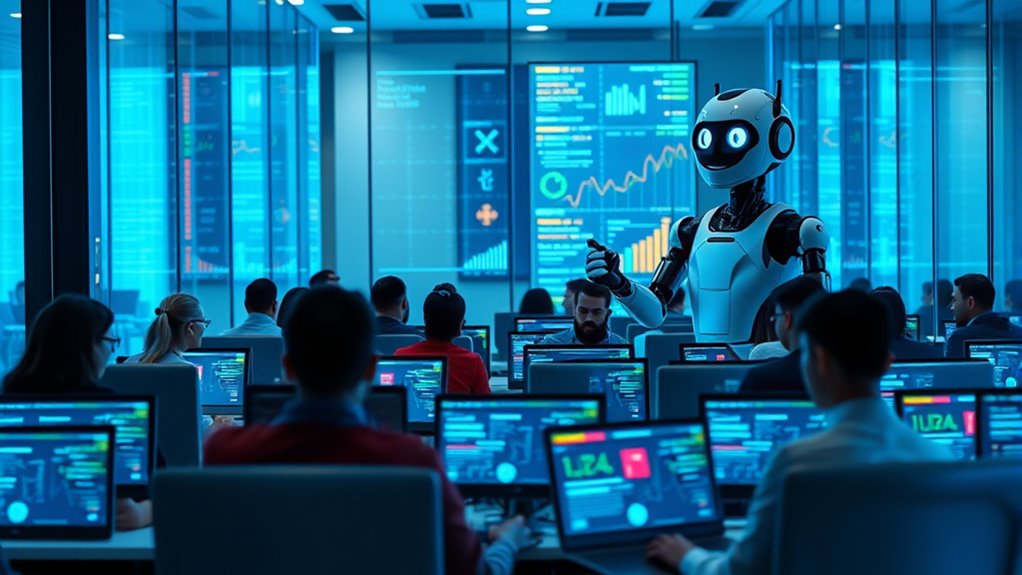
The rise of algorithmic management has transformed modern workplaces by automating many traditional supervisory tasks. In countries like the U.S., about 70% of large employers use automated systems to oversee operations, especially in sectors such as logistics, retail, and manufacturing. These tools monitor employee performance, track productivity, and help make decisions faster and more consistently. This trend is driven by the promise of increased efficiency and output. However, it also affects workers’ experiences—many report feeling less autonomous and connected to their work, leading to increased stress and lower job satisfaction. As technology advances, these systems become more sophisticated, analyzing vast data to guide decisions. This shift signals a significant change in how workplaces are managed, with automation playing a central role, impacting employee well-being and organizational culture. Consequently, organizations must balance efficiency gains with considerations of workplace humanization to ensure sustainable and positive employee experiences. Recognizing the importance of employee engagement is crucial for fostering a healthy work environment amid increasing automation. Additionally, understanding the impact of automation on workers’ mental health is essential for developing supportive workplace policies. Furthermore, implementing ethical guidelines for algorithmic decision-making can help mitigate potential negative effects on employees.
Benefits Managers See in AI-Driven Decision-Making
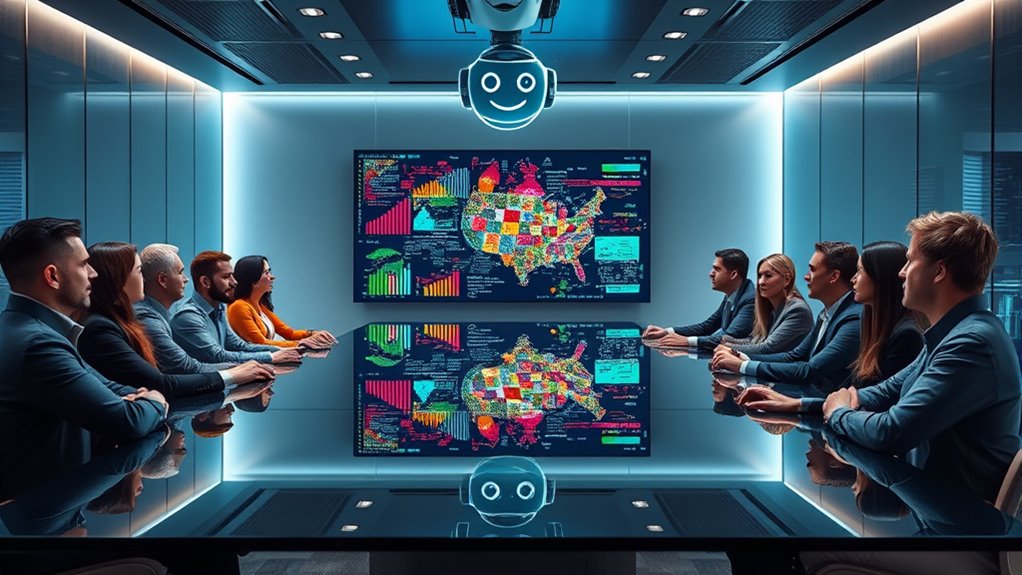
AI-driven decision-making helps you maintain consistent choices across your organization, reducing variability and bias. It also speeds up data analysis, allowing you to act quickly on insights that would otherwise take hours or days. As a result, your operations become more efficient, saving time and resources while improving overall performance. Additionally, leveraging AI in decision processes enables organizations to tap into long-term productivity gains, fostering sustainable growth and competitive advantage. Incorporating predictive analytics considerations into AI algorithms can further enhance the precision of decision-making processes.
Enhanced Decision Consistency
Enhanced decision consistency is a key advantage that managers gain from adopting AI in their processes. It guarantees decisions are made uniformly by applying predefined rules, reducing human bias and fluctuations. AI’s predictive analytics help you anticipate outcomes and make proactive choices, while streamlining workflows eliminates bottlenecks. This leads to more reliable, fair decisions aligned with a standardized playbook, promoting fairness and impartiality. Benefits include increased efficiency, error reduction, and improved outcomes, as decisions are based on data and consistent criteria. Transparency improves, and bias diminishes. AI also supports 24/7 operations and better workload management. This consistency strengthens strategic planning, risk management, and market analysis, giving your organization a competitive edge. Additionally, track development techniques are essential for creating compelling trailer music narratives that resonate with audiences. Implementing algorithmic decision-making can further enhance these benefits by automating complex evaluations seamlessly.
Accelerated Data Analysis
Adopting AI for decision-making accelerates data analysis, enabling managers to process massive datasets swiftly and accurately. You can extract insights from large volumes of data in real time, revealing patterns that might go unnoticed manually. AI algorithms excel at recognizing complex trends, boosting predictive capabilities and providing immediate insights to inform quick decisions. This reduces errors common in human analysis and enhances the reliability of results. With AI, you gain a clearer understanding of market dynamics, customer preferences, and potential risks by analyzing data continuously and in depth. This rapid, precise analysis supports strategic planning and helps you stay ahead of competitors. Overall, AI-driven data analysis empowers you to make smarter, faster decisions based on extensive, real-time information.
Improved Operational Efficiency
Implementing AI in your operations considerably boosts efficiency by increasing task completion rates and reducing manual labor. AI tools elevate business user throughput by an average of 66%, enabling support agents to handle 13.8% more inquiries per hour and professionals to produce 59% more documents each hour. Programmers leverage AI to complete 126% more projects weekly, while overall workforce productivity can increase by up to 40%. Automation of routine tasks frees employees to focus on higher-value work, managing scheduling, reporting, and decision processes with minimal human intervention. This streamlines workflows, reduces errors, and accelerates turnaround times. Additionally, AI-driven management adapts swiftly to changing needs, allowing larger teams to operate efficiently without proportional increases in oversight. Craft and Textiles innovations also inspire new ways to integrate AI into creative industries, further enhancing operational flexibility. Recognizing team dynamics can help organizations foster collaboration and improve overall performance in AI-enabled workplaces. The result is a more agile, cost-effective, and scalable organization. Incorporating personal growth principles can help teams adapt more effectively to technological changes and improve overall resilience. Furthermore, understanding dog names can foster better team bonding and morale in workplace environments that embrace pet-friendly policies.
Challenges and Concerns Surrounding Algorithmic Oversight

You might feel confident in algorithmic oversight’s efficiency, but transparency and trust remain major concerns. When decisions are made by unclear or opaque systems, workers can lose confidence and feel uncertain about their rights. These issues pose significant risks to worker well-being and demand careful attention. The digital platforms used to facilitate these processes can sometimes obscure how decisions are reached, further eroding trust. Widespread adoption of these tools across firms underscores the urgent need for clear guidelines and safeguards. Ensuring that decision-making processes are understandable and accessible can help build trust and promote ethical use of these algorithms, particularly in environments where natural environments and community well-being are impacted. Incorporating transparent algorithms and explainable AI can also improve accountability and worker confidence in these systems.
Transparency and Trust Issues
Have you ever wondered how much you can trust automated management systems when their decision-making processes are kept hidden? The complexity and proprietary nature of algorithms often mean you don’t see how decisions are made, creating a transparency gap. Without clear explanations, it’s hard to understand why certain evaluations or assignments happen, fueling distrust. Limited access and technical jargon make it even tougher for you to assess or challenge these decisions. When critical criteria are hidden, errors or biases can go unnoticed, raising fairness concerns. This opacity damages trust, fosters suspicion, and can make you feel surveilled rather than supported. As a result, workplace relationships suffer, and engagement drops. Without transparency, accountability becomes difficult, leaving you uncertain about your job security and performance evaluations. Invasive surveillance practices can also erode workers’ privacy, further contributing to feelings of distrust and alienation.
Worker Well-being Risks
The opacity of algorithmic management not only damages trust but also raises serious concerns about worker well-being. When algorithms limit your decision-making and control over work routines, you may feel powerless and dissatisfied. This loss of autonomy often results in increased stress, anxiety, and emotional exhaustion, especially when you’re constantly monitored and receive real-time feedback. Unpredictable workloads and last-minute schedule changes can disrupt your work-life balance, causing financial and physical health issues. Additionally, strict oversight may lead to physical exhaustion or injuries and heighten mental health risks like depression. Workers also perceive algorithmic decisions as unfair and opaque, deepening feelings of powerlessness and mistrust. Overall, algorithmic oversight can markedly undermine your psychological, emotional, and physical health at work.
How Employees Are Affected by Automated Supervision

How does automated supervision shape employees’ experiences at work? It often makes your day feel more controlled and less autonomous. With electronic monitoring, you might feel constant pressure to perform perfectly, which can increase stress and anxiety. Many workers are unaware of what data is collected about them or how it’s used, leading to feelings of invasion and distrust. This surveillance can lower your job satisfaction and make you feel less confident in your abilities. You may also notice a decrease in motivation because you’re monitored more than supported. Safety risks could rise, as pressure from surveillance might cause mistakes or accidents. Overall, automated supervision can create a workplace environment that feels invasive, stressful, and less empowering.
The Need for Clear Policies and Ethical Guidelines

Automated supervision can make workplaces feel intrusive and unpredictable, highlighting the need for clear policies and ethical guidelines to govern AI use. You should begin by establishing a purpose statement that explains why AI guidelines are necessary. Define who must follow these policies, including employees, contractors, and third-party vendors. Work closely with legal teams to ensure compliance with existing laws. Develop an ethical framework that promotes AI benefits without causing harm. Include employee acknowledgment sections to secure buy-in and enforce adherence. Your policies must clearly define AI tools, address transparency and bias, and specify responsible use cases. Regularly review and update policies to keep pace with technological advances, guaranteeing your workplace remains fair, compliant, and ethically sound.
Future Outlook: The Coexistence of Humans and Algorithms

What does the future hold for workplaces where humans and algorithms work side by side? It’s a landscape where technology boosts productivity, decision-making, and innovation. You’ll see AI and algorithmic tools automating routine tasks, freeing you to focus on strategic and creative work. Their real-time data analysis makes decisions more data-driven and objective, enhancing overall efficiency.
Here are three key developments to expect:
- Increased collaboration between humans and AI, fostering innovation.
- AI empowering your creativity rather than replacing it.
- A balanced workplace where ethical considerations and trustworthiness are prioritized.
As this coexistence evolves, your role will shift towards overseeing AI integration, emphasizing human strengths like empathy and critical thinking. The future is about synergy, not competition.
Navigating Trust and Transparency in Automated Work Environments

Trust is the foundation of effective collaboration in workplaces increasingly governed by algorithms. Yet, only 37% of workers have high confidence in their organization’s responsible use of data. Despite this, about 71% trust their employers to deploy AI ethically, especially compared to universities, tech firms, or startups. Overall, 73% trust their employers to do the right thing, far above the 45% trust in government institutions. Transparency plays a vital role; clear understanding of AI decision-making boosts trust and reduces perceived threats. However, too much transparency can backfire, causing privacy concerns. Striking a balance is key: open enough to build confidence without overwhelming employees. Trust, fostered by transparency, enhances engagement, productivity, and acceptance of AI-driven management.
Frequently Asked Questions
How Do Companies Ensure Algorithmic Fairness and Prevent Bias?
You can guarantee algorithmic fairness by using diverse and representative datasets, regularly auditing algorithms for biases, and applying fairness metrics. Incorporate transparent processes, like explainable decision-making, and hold algorithms accountable. Implementing blind hiring practices and continuous monitoring helps identify issues early. Establishing strong regulatory frameworks and prioritizing fairness in design ensures that algorithms treat all groups equitably, reducing bias and promoting fair outcomes across your organization.
What Training Is Provided to Managers for AI Oversight?
You’re stepping into a world where AI oversight is essential—don’t underestimate its importance! Managers receive foundational training on AI concepts, tools, risks like misinformation, and ethical responsibilities. Many take specialized leadership courses to sharpen oversight skills. Personalized AI-driven learning adapts to your needs, while organizations invest heavily to guarantee you’re equipped to evaluate AI outputs, manage bias, and uphold ethical standards—making your role critical in shaping responsible AI use at work.
How Are Employee Rights Protected Under Algorithmic Management Systems?
You might wonder how your rights are protected under algorithmic management systems. Currently, protections are often weak, leaving you vulnerable to unfair decisions and invasive monitoring. You need new rights, like data control and collective action, enforced by specialized regulators. Laws should be updated to hold companies accountable, ensure transparency, and preserve your autonomy. Without these measures, your ability to challenge unfair treatment or organize could be severely limited.
What Are the Legal Implications of AI Making Workplace Decisions?
Did you know 60% of employers use AI for hiring decisions? When AI makes workplace decisions, the legal implications are significant. You need to guarantee compliance with employment laws, avoid bias, and maintain transparency. If AI results are biased or discriminatory, you could face lawsuits or regulatory penalties. Regular bias audits, clear policies, and human oversight are essential to mitigate legal risks and protect employee rights.
How Can Workers Challenge or Appeal Algorithmic Judgments?
You can challenge or appeal algorithmic judgments by first requesting access to the data and understanding how the decision was made. Use your knowledge of the process to identify biases or unfair treatment, and involve your union or technical experts for support. Advocate for transparency tools and ethical guidelines, and push for regulatory frameworks that protect your rights. Staying informed and organized increases your chances of successfully contesting algorithmic decisions.
Conclusion
As you navigate this new terrain, remember that algorithms are like GPS guides—helpful but not infallible. Trust and transparency are your compass, guiding you through the maze of automated management. Embrace the balance where humans and bots work together, like a well-choreographed dance. By staying informed and mindful, you’ll turn this high-tech landscape into a place where your voice matters, and the human touch still shines amid the algorithms’ quiet hum.
